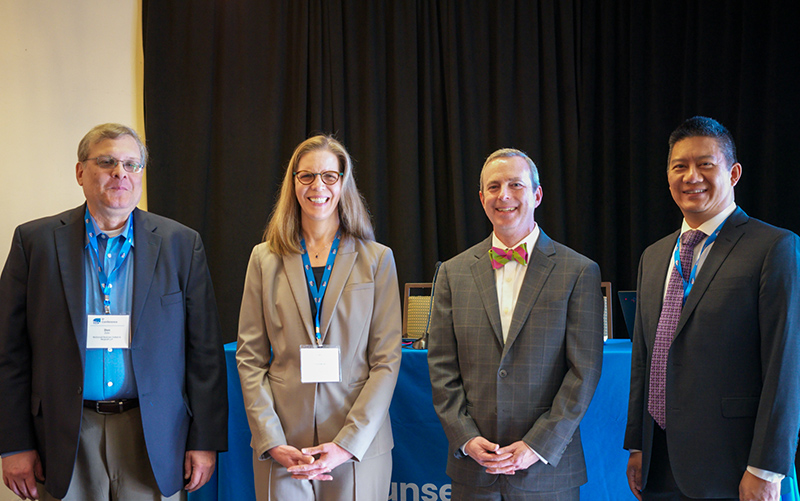For evidence of the link between biotech innovation and intellectual property protections, look no further than the United States.
The world leader in biotech, the U.S. is also listed as the leader in IP protection in the U.S. Chamber’s 2024 International IP Index. That’s probably why some competitors seek to limit global IP protections.
“We often hear calls in the international arena to weaken safeguards for IP, supposedly to help lower-income countries access medicine,” says Hans Sauer, Vice President for Intellectual Property at the Biotechnology Innovation Organization (BIO). “In truth, stronger IP protection encourages drug research and enables patent holders to share medical breakthroughs worldwide.”
Given the importance of IP to the biotech industry, BIO prioritizes work to strengthen and update patent systems in the U.S. and abroad. Legislation can sharpen legal clarity on patents, and sensible IP approaches enable us to use new technologies such as artificial intelligence tools that increase competitiveness.
Every year, World IP Day is held on April 26, and this year it features a focus on how IP can help us achieve the UN Sustainable Development Goals (SDGs). The day underscores why BIO works year-round to ensure IP is protected.
Providing an incentive for R&D
Current U.S. dominance in pharmaceutical development is evident from December 2022 figures showing the country was solely responsible for 61% of medicines approved by the U.S. Food and Drug Administration (FDA) between 2011-2020.
Maintaining this lead requires extensive research and development, which can only be funded if drug developers know they can protect their IP, according to Frank Watanabe, President and CEO of Arcutis Biotherapeutics and a BIO board member.
“Biotechnology stands out as the most R&D-intensive industry in the U.S. economy. As a percentage of sales, biotech investment exceeds that of all other manufacturing sectors by an average of six times,” Watanabe writes in The Hill. “Companies that invest resources on that scale need assurance that they will have the opportunity to recoup their investments if they are successful. Strong intellectual property (IP) protections are critical to the pursuit of new treatments.”
As biotech grows more competitive globally, experts say it is essential for the U.S. to maintain its robust IP regime.
“Europe used to be a leader in biopharma innovation, but drug price controls and weaker IP protections harmed the innovative ecosystem in Europe and its ability to attract investment for biotech development,” says Justin Pine, BIO’s Senior Director for Global IP and Digital Policy. “With China stating its ambition to become the global leader in biotech, the U.S. needs to guard its intellectual property and ensure we continue to have the best patent system in the world.”
IP drives success against COVID
The benefits of IP were made clear during the COVID-19 pandemic. The rapid development of vaccines was enabled by years of IP-protected private research, as the American Medical Association notes.
Assured their patents would be respected, vaccine makers were able to share their innovations internationally. According to one report, there were 374 global manufacturing and supply chain announcements for COVID-19 vaccines and 177 collaborations established for production and commercialization of COVID-19 treatments.
These private, IP-based collaborations eliminated the need for a World Trade Organization (WTO) decision to waive IP protections for COVID-19 vaccines. The waiver, which allowed countries to ignore IP protections and produce vaccines locally, was never used.
“IP isn’t the problem. It’s the framework that provides solutions,” says Nancy Travis, BIO VP for International Affairs, explaining BIO’s work in opposition to WTO IP waivers. “As governments struggle to finance health breakthroughs, IP protections enable private collaboration and market-driven biotech innovation, to the benefit of science and public health.”
IP for plants help us meet UN SDGs
Biotech advances in agriculture play a major role in meeting the 17 goals set out in the U.N. SDGs by reducing our climate impact while increasing food security.
Since the Plant Patent Act of 1930, breeders who develop new plants have the right to patent them. In 1980, the U.S. Supreme Court made it clear genetic alterations could be patented when it upheld a claim that has been called the first patenting of a living thing—a microbe genetically modified to consume oil spills.
“Gene editing breakthroughs are a game changer, allowing production of more nutritious, drought-resistant crops, and other developments to make agriculture more sustainable and resilient,” says David Lachmann, BIO’s Senior Director of Federal Government Relations. “The ability to patent gene editing means investors can support R&D, driving remarkable growth in this area.”
Sustainable aviation fuels, produced with biotech, offer the fastest way to reduce the carbon output of commercial air travel. And synbio uses biotech innovations, like Ginkgo Biowork’s process of fermentation with gene-edited yeast, to create more sustainable versions of a wide variety of consumer goods.
Room for improvement in U.S. patent systems
Supreme Court decisions have undermined confidence in whether innovations can survive patent challenges. Legislation is needed to provide legal clarity that enables innovation by ensuring returns on R&D investment.
The bipartisan Patent Eligibility Restoration Act (PERA) would increase patent-eligible innovations by specifying the few patent-ineligible categories—like ideas based on a mental process that can be done in the human mind or a gene already existing in the human body.
“It is critical that the future path of our patent system is one that preserves and maintains the incentives for innovation that have made the United States the global leader in medical, agricultural, industrial, and environmental biotechnology,” BIO VP Sauer says of the legislation.
AI is another area where BIO is seeking to maintain straightforward, enforceable patents.
“Current patent law clearly gives IP to a human being with a new idea,” according to Lachmann. “AI is an important tool for innovation, but it is only a tool. The person who used and operated the AI is the one who conceived of the resulting innovation and is therefore listed as the inventor on the patent.”
Despite the clarity in existing laws, guidance issued in February by the U.S. Patent and Trademark Office (USPTO) suggests the possibility of treating inventions developed with AI differently from inventions developed by other means.
“Our patent law should support, not hinder, the responsible use of AI to achieve transformative results for the economy and human health,” writes Claire Laporte, Ginkgo Fellow and former Head of Intellectual Property at BIO member Ginkgo Bioworks in April 10 testimony for Congress. “Subjecting patent applications to new analytical and disclosure requirements depending on which tools were used in making the invention can only hurt our global competitiveness.”
Threats from abroad
The ability for U.S. biotech to expand is limited by IP insecurity abroad, such as the above-mentioned TRIPS waiver for COVID-19 vaccine IP.
“If IP receives global protection, technology can move freely around the world, driving further innovations and enabling universal patient access to medicines,” says Travis. “Unfortunately, the uneven level of IP protections in different countries makes it harder to share innovation.”
BIO’s latest submission to the U.S. Trade Representative’s Special 301 Report, a summary of concerning IP practices abroad, calls out several threats:
- Compulsory licenses: some governments can grant compulsory licenses (CLs) that take IP rights from a patent owner and give it to a third party.
- Technology localization measures: Similar to CLs, these force patent holders seeking to export their technology to localize R&D or manufacturing or force transfer of their IP to a local party.
- Regulatory data protection: Biotechnology innovators must submit comprehensive information to a country’s regulatory authorities for marketing approval. Inadequate protection allows this sensitive information to be disclosed or exploited for commercial use.
- Patent acquisition obstacles: These can include prohibiting patents on certain types of inventions; patent office backlog; challenges to submitting patent applications; new disclosure obligations for patents; and difficulties with patent adjustments.
- Patent enforcement challenges: These include a lack of efficient, early resolution mechanisms for patent disputes, the ability for a party to use a patent that is under dispute, and other legal obstacles.
Celebrating IP on Capitol Hill on May 1
Federal recognition of the importance of IP will include a May 1 gathering on Capitol Hill, with discussions from Kathi Vidal, Director of the U.S. Patent and Trademark Office, Rep. Darrell Issa (R-CA), Chair of the House Judiciary Subcommittee on Courts, Intellectual Property, and the Internet, and other officials.
The theme of this event, which will also be live-streamed, is the contribution of IP to the UN SDGs. Find out more and register here.
“BIO looks forward to fruitful discussion about ongoing efforts by our government on IP protection, and areas where new initiatives are needed,” says Pine. “U.S. vigilance in the face of international threats to IP, and continued efforts to strengthen our patent system, require concerted policy as well as public-private collaboration.”




